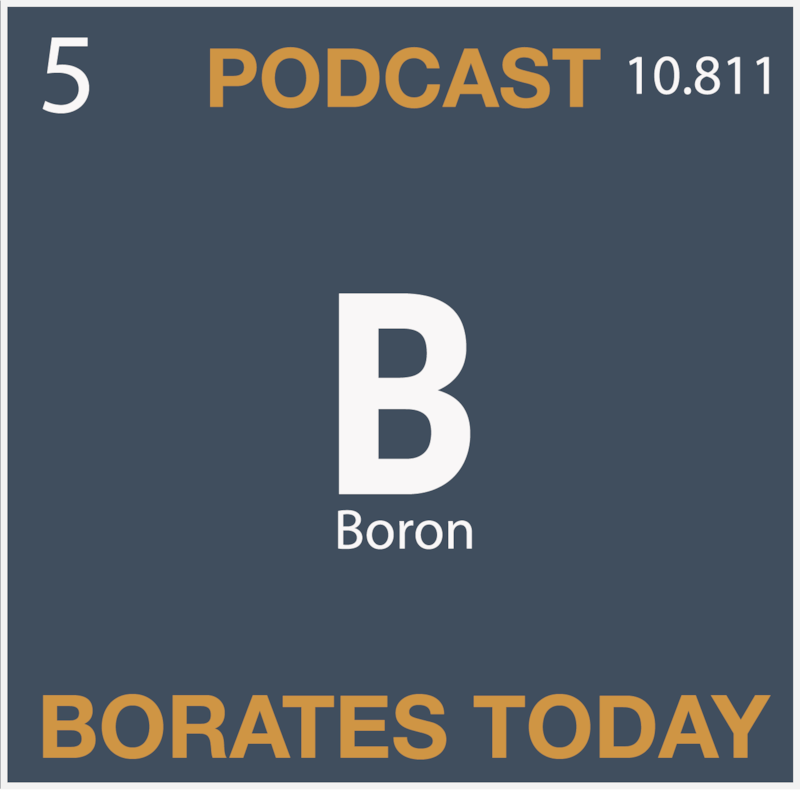
Shownotes
Today, we're going to look at boron-based furan polymers. Boron-based furan polymers are a new class of renewable energy materials based on boron.
These materials can provide portable energy sources, serve as catalysts in chemical reactions, and can potentially be used as electrode materials in lithium-ion batteries. They are also highly biodegradable.
Transcripts
Welcome back to the Borates Today podcast.
Brendan:Each week we cover a topic that is relevant to the industry and timely.
Brendan:We cover the latest industry news.
Brendan:Who are the key players in the sector?
Brendan:What are the latest trends, driving demand and supply for boron.
Brendan:What is the science behind boron and who's doing valuable research into
Brendan:new boron applications and benefits?
Brendan:We look at how boron helps in advanced energy, in food security,
Brendan:and in providing nutrition.
Brendan:So don't forget to check out boron applications and benefits
Brendan:on our website borates.today.
Brendan:Today, we're going to look at boron based furan polymers.
Brendan:boron based furan polymers are a new class of renewable
Brendan:energy materials based on boron.
Brendan:These materials can provide portable energy sources, serve as catalysts
Brendan:in chemical reactions and can potentially be used as electrode
Brendan:materials in lithium ion batteries.
Brendan:They are also highly biodegradable.
Brendan:Boron-based Furan Polymers.
Brendan:There's a lot of research going on into boron at the cutting edge of science for
Brendan:its advanced and green energy potential.
Brendan:In combination with furan polymers.
Brendan:researchers believe that boron can offer a sustainable solution
Brendan:for light and energy on the go.
Brendan:Most furan based products degrade quickly under ambient circumstances, exposing
Brendan:the environment to hazardous compounds.
Brendan:On the other hand, boron linked furans can resist temperatures of
Brendan:up to 300 degrees centigrade, and stay unaffected by light for months.
Brendan:These furan polymers have a greater luminosity and are more soluble
Brendan:than traditional thiophene-based compounds, making synthesis
Brendan:easier and lowering solvent use.
Brendan:Because furans are biodegradable, these materials are more likely to be reused.
Brendan:So, what are the potential applications?
Brendan:Boron-based furan polymers open up a variety of potential uses
Brendan:beyond organic electronics.
Brendan:They can help provide a sustainable and clean source of electricity.
Brendan:Solar cells are unique, organic materials using crystalline silicon
Brendan:that harnesses the sun's energy.
Brendan:Presently, these materials are produced with crude oil or natural
Brendan:gas, which is not sustainable.
Brendan:Scientists are now seeking alternatives.
Brendan:Portable energy sources are favored by outdoor enthusiasts and others who carry
Brendan:small solar plants, usually made of tin and other non-sustainable materials.
Brendan:These sources enable people to charge their smartphones while on the move.
Brendan:Flexible, thin and lightweight solar panels can be mounted to curved
Brendan:surfaces, such as roofs on mobile homes or attached to outdoor clothing.
Brendan:As the material's characteristics develop, boron-based furan polymers
Brendan:can be utilized to produce sensors that detect hazardous amines in the air.
Brendan:Furthermore, they can be employed as catalysts and electrode
Brendan:materials in lithium ion batteries.
Brendan:This discovery will pave the way for a more sustainable energy
Brendan:source and aid in providing green energy to a worldwide population.
Brendan:What Research is Going on?
Brendan:Boron-based furan polymers are already used in organic electronics.
Brendan:According to Wikipedia, organic electronics is a field of material
Brendan:science concerning the design, synthesis, characterization, and
Brendan:application of organic molecules or polymers that show desirable, electronic
Brendan:properties such as conductivity.
Brendan:This is a promising field in many respects but there are challenges in use.
Brendan:For instance, the polymers decompose quickly in the
Brendan:presence of light and oxygen.
Brendan:However, a doctoral student from the university of Wurtzburg in Germany
Brendan:is now working on synthesizing and characterizing these materials using
Brendan:more environmentally friendly methods.
Brendan:This will lead to more efficient processes, lowering energy
Brendan:requirements and reducing reagents.
Brendan:The research is ongoing.
Brendan:Professor Holger Hilton and his team of scientists the Wurtzburg
Brendan:Faculty of Chemistry have developed a sustainable, organic, electronics
Brendan:source manufactured in the home.
Brendan:Besides organic electronics, these polymers have various applications
Brendan:such as renewable energy source.
Brendan:Among other uses, they can be used for solar cells, light-emitting diodes
Brendan:displays or electronic circuits.
Brendan:Professor Helton hopes to improve these synthesis processes further
Brendan:to make them more sustainable.
Brendan:He explains why these strategies are good for the environment.
Brendan:And I quote,
Brendan:" The polymerization of boron and furans as well as the production of
Brendan:purely organic polymers generally leads to high undesirable waste.
Brendan:Often, these are organic tin compounds.
Brendan:There's no requirement for metals with our approach and
Brendan:no harmful waste degenerated".
Brendan:With all of these advantages in terms of sustainability., It's no surprise that the
Brendan:German Federal Environmental Foundation, Deutsche Bundesstiftung Umwelt, is funding
Brendan:Maximillian Fest's dissertation project.
Brendan:Beyond organic electronics, the addition of boron to furan-based polymers opens
Brendan:up a number of new possibilities.
Brendan:Professor Helton says it can be used for example, to build sensors
Brendan:that detect hazardous amines.
Brendan:As for new, green, clean sources of energy, born and based
Brendan:polymers can produce liquid fuels.
Brendan:This material contains hydroxyl groups and various furan rings.
Brendan:The resulting compounds can be used for organic electronics and solar cells.
Brendan:These polymers are also used to make light-emitting diodes and displays.
Brendan:The material will eventually be a green clean source of energy.
Brendan:Further they can be used in the manufacturing of flexible
Brendan:electric chromic devices.
Brendan:Finally, boron-based fibers are another excellent, renewable
Brendan:and sustainable energy source.
Brendan:They do not contribute to global warming or air pollution.
Brendan:A reduction in temperature is another way to create renewable materials.
Brendan:Natural fibers are renewable and have a lower processing temperature
Brendan:than synthetic materials.
Brendan:And of course they're environmentally friendly.
Brendan:And that's all for today.
Brendan:For more information on boron based forum polymers, please refer
Brendan:to the Borates Today website.




